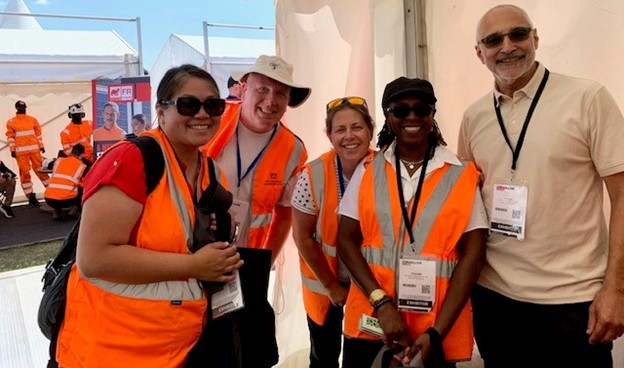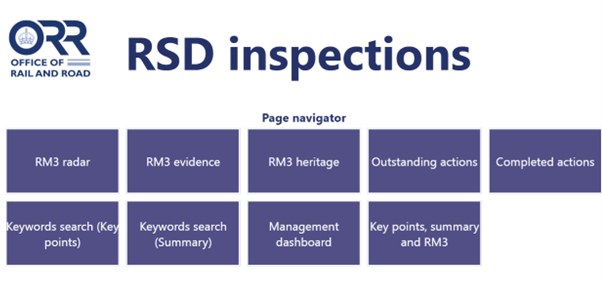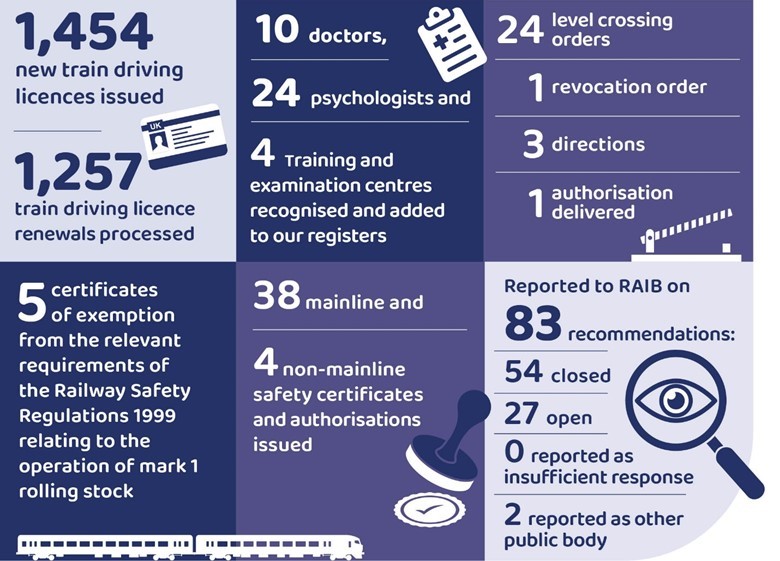
Case Study 6: Trainee Inspector
 In September, we proudly celebrated the graduation of our first two inspectors who achieved their NEBOSH postgraduate diplomas in railway occupational health and safety. These inspectors are the first to complete the entire qualification solely through our in-house ORR regulatory training programme.
In September, we proudly celebrated the graduation of our first two inspectors who achieved their NEBOSH postgraduate diplomas in railway occupational health and safety. These inspectors are the first to complete the entire qualification solely through our in-house ORR regulatory training programme.
Previously, much of our training was outsourced to the Health and Safety Executive (HSE). However, recognising the value of a tailored approach, we made a strategic decision to bring all training in-house. The recent graduation marks the culmination of three years of dedicated effort by our Learning and Development team, who developed and delivered the comprehensive courses and materials.
Throughout this process, the team ensured that our training met the rigorous academic standards required of a NEBOSH-accredited learning partner. As a result, we now offer a robust, internationally recognised regulatory training programme and qualification. This achievement not only reflects our commitment to regulatory excellence but also ensures that we will continue to maintain a highly capable and competent workforce prepared to meet the challenges of the future.
Improving legislation and processes for train driving licences
The Train Driving Licences and Certificates Regulations 2010 (TDLCR), which implemented a European Directive establishing an EU-wide system of train driver licensing and certification based on common standards, have facilitated cross-border rail operations, increased labour market flexibility, and improved public confidence in rail safety. To date, we have issued over 27,000 licences to train drivers in Great Britain.
As with all UK secondary legislation, TDLCR undergoes a post-implementation review (PIR) every five years to assess its effectiveness in meeting original objectives. The most recent PIR, published in May 2023, identified a clear case for reform. Throughout 2024, we worked closely with the DfT to explore options for streamlining the licensing regime, reducing prescriptive requirements, and incorporating mechanisms that accommodate future technological and medical advancements. These reforms are expected to significantly lessen the regulatory burden on the industry.
A key early outcome of this review was an agreed ORR policy position supporting the reduction of the minimum licensed train driver age from 20 to 18 years. The DfT consulted on this proposal during May and June 2024, and the Secretary of State formally announced it in May 2025 as part of the Government’s Plan for Change, aimed at increasing youth workforce participation. Legislative changes to implement this policy are anticipated in 2025 to 2026, accompanied by further consultations on broader reforms, as detailed in our 2025 to 2026 business plan.
Alongside legislative reform, we enhanced our web-based portal to provide a more efficient licensing service for train driver employers. The IT project will conclude in 2025 to 2026, introducing additional functionality, including direct employer access to update driver records. During the year, we processed increasing volumes of new and renewed licences (see infographic below) and collaborated closely with train operators to develop improved forecasting methodologies to anticipate future demand, as highlighted in the following case study.
Case Study 7: Scotrail – Train driving data
We maintain a comprehensive register of all train driving licences issued across Great Britain, including details of the driver, their employer, and licence status. While maintaining this register is a core statutory duty, we increasingly utilise this data at both operator and national levels to identify emerging trends and inform strategic planning.
One notable trend is the significant rise in new train driving licence applications. In 2023 to 2024, we received 1,140 applications nationwide, which increased by 27.5% to 1,454 applications in 2024 to 2025. Beyond adjusting our resource deployment to meet this growing demand, these patterns provide valuable insight into broader shifts within the rail industry.
To better understand these changes, we engaged directly with operators, including ScotRail, to discuss the trends and gather their perspectives. ScotRail reported a 67% increase in licence applications, attributing this to a strategic five-year recruitment plan aimed at addressing workforce challenges. A key driver behind this surge is the ageing profile of their current drivers, particularly those with over 35 years of service, coupled with a shift towards part-time working preferences among previously full-time staff.
ScotRail also highlighted operational changes such as reducing reliance on rest-day working and a commitment to offering more family-friendly schedules, which have influenced recruitment needs. Additionally, with a substantial number of licence holders approaching renewal, ScotRail forecasted a spike in licence expirations around 2027 and 2028.
In response, we collaborated with ScotRail to develop a staggered licence renewal plan, designed to prevent administrative bottlenecks and ensure smoother processing.
Moving forward, we will continue to engage closely with train operators to understand their workforce priorities and pressures, using licence data collaboratively to better anticipate and prepare for future demand.

Other policy developments and improvements
We started work to prepare for the next PIR of the Railways and Other Guided Transport Systems (Safety) Regulations 2006 (ROGS), which we conduct on behalf of the DfT. These regulations underpin the safety management framework for a broad range of rail systems, including mainline railways, metros (e.g., London Underground), tramways, light rail, and heritage railways, requiring operators to maintain a safety management system (SMS) and hold a safety certificate or authorisation approved by ORR.
While the PIR report is scheduled for August 2026, we have established stakeholder engagement and evidence-gathering processes designed to be effective and proportionate, mindful of ongoing rail reform consultations. The 2026 PIR will evaluate whether ROGS and associated Common Safety Methods remain effective, with consideration of the UK’s EU exit, wider rail reforms, and the establishment of Great British Railways.
We updated our Health and Safety Crowding Position Statement, originally published in 2019, which articulates our stance on crowding on trains and at stations and sets expectations for operators and passengers. Although no significant new research prompted fundamental changes, we refined the language and presentation to improve clarity and accessibility for all stakeholders.
Since 1 January 2021, following the UK’s departure from the EU, the French safety regulator L’Etablissement Public de Sécurité Ferroviaire (EPSF) has assumed National Safety Authority (NSA) responsibilities for the French half of the Channel Tunnel (Channel Fixed Link). Meanwhile, the binational Intergovernmental Commission (IGC) remains the NSA for the UK half. Throughout the year, we supported the DfT and French counterparts in developing updated binational legislation reflecting the post-Brexit regulatory landscape. The new legislation, signed by both governments in April 2025, is expected to come into effect later in the 2025 to 2026 work year, at which point NSA responsibilities for the UK half of the Channel Fixed Link will transfer from the IGC to ORR.
Workshops were held in December 2024 and January 2025 with tunnel duty holders to help facilitate a smooth and effective transition through understanding the implications of the changes.
Reviewing our frameworks and processes
We continue to improve our internal processes such as enhancements to our case management system and inspection report template and continuing to review our approach to our Strategic Risk Chapters. We are also launching a new Learning and Development Strategy to improve the way we provide training and learning to all our staff, regardless of whatever stage of their career they are at.
We completed an internal review into the railway interoperability regulations and how they interact with safety requirements. This highlighted a number of areas where we can improve processes now, and issues for further consideration when there is an opportunity to review interoperability requirements. We worked closely with DfT and RSSB on the review of National Technical Specification Notices (NTSNs), and the revised standards have now been published. We are now working with RSSB to produce new NTSN Guidance and to provide our input to their review of the overall standards framework, which will result in changes to the Railway Standards Code and Manual.
We reported on our work to review how businesses assess the costs and benefits of their safety interventions which is available at – Assessing the costs and benefits of health and safety interventions in rail An industry-wide review. We wanted to understand how and when cost estimates are compiled for safety initiatives, and whether reasonable practicability is systematically tested. Through working closely with stakeholders, we identified important learning points to support best practice in assessing the costs and benefits of safety related decision making and improve consistency across the industry and within Network Rail.
Case Study 8: Enhancing regulatory effectiveness through digital innovation – ORR’s inspection app
Modernising our approach to health and safety regulation
As a modern, enabling regulator, we are committed to continuously improving how we carry out our regulatory activities. A key part of that is investing in digital tools that help us work more effectively and make better use of safety data. One of our most significant developments this year has been the launch of a new Inspection App, designed to transform how we record, analyse, and act on findings from our frontline inspections.
We developed the app using Microsoft Power Apps and integrated it within our Microsoft Teams environment. It enables our inspectors to record inspection data in real time using mobile devices, apply RM3 ratings on-site, and feed that information directly into our broader risk and quality assurance systems.
The app is already delivering key benefits:
- Efficiency: Our Inspectors can now log inspections via phone, tablet, or desktop, streamlining admin and freeing up more time for regulatory work.
- Smarter insight: Structured data collection supports trend analysis and helps us identify and address emerging risks more quickly.
- Accountability: Consistent record-keeping strengthens internal governance and improves the clarity of our external reporting.
- Improved communication: A shared digital platform supports better collaboration internally across teams and in our engagement with external stakeholders.
By standardising how we capture inspection data across the country, the App is helping us build a stronger, more reliable evidence base. This supports more targeted interventions, better safety outcomes, and a clearer demonstration of our impact as a modern, risk-focused regulator.

Working with other regulators, safety authorities, and industry bodies to share best practice and aid continuous improvement
Our international engagement
Our international engagement strategy reflects the post-EU Exit environment and aligns with government priorities, enabling us to focus efforts for maximum benefit to ORR and the wider Great Britain rail industry. Throughout the year, we responded to numerous international requests for engagement and participated in key forums, including the International Railway Safety Council in Vienna in September 2024. We also delivered RM3 training to Turkish State Railways and continued to provide operational support to Northern Ireland under the refreshed Agency Agreement with the Department for Infrastructure Northern Ireland, which remains the safety authority for the region.
We maintained observer status at National Safety Authority (NSA) Network meetings, led by the European Union Agency for Railways, keeping abreast of developments relevant to the Channel Tunnel and domestic railway regulation.
Our bilateral engagements with international counterparts – including Australia, Central Japan Railway Company, and the Transport Safety Investigation Bureau of Singapore - facilitated valuable exchanges of knowledge and best practices. We continued active collaboration through the International Liaison Group of Government Railway Inspectorates (ILGGRI), for which we provide the secretariat, fostering a global forum to share expertise on health and safety matters.
Our external health and safety committee
We chaired three meetings of the Railway Industry Health and Safety Advisory Committee (RIHSAC), which brings together representatives of employers, employees, passengers, and government bodies to offer advice and constructive challenge to our Board on health and safety matters. The range of topics discussed included mental and occupational health; passengers’ health, safety, and welfare needs during stranded train incidents; weather-related risk management; development of technology around level crossings, particularly flow footbridge initiative from Network Rail; outcomes of the annual ORR risk profiling exercise; Rail Sector Transformation Programme (RSTP) – safety assurance update; and annual health and safety reports published by ORR, RSSB and RAIB.
Our engagement and collaboration with other regulators
We collaborated regularly with the Health and Safety Executive (HSE) across regulatory policy and operational domains of shared interest. Our inter-agency agreements with HSE, covering safety by design and road vehicle incursion enforcement, were reviewed and found effective in supporting our regulatory objectives.
Following HSE’s post-implementation review of the Reporting of Injuries, Diseases and Dangerous Occurrences Regulations 2013 (RIDDOR), we reviewed and updated our policies, guidance, and reporting arrangements for the rail sector to enhance clarity, remove outdated material, and improve usability of reporting forms. Internal RIDDOR processes were also documented with greater precision.
Collaboration with the Office for Nuclear Regulation (ONR) led to the revision of the ORR and ONR Memorandum of Understanding (MoU), which defines cooperation in policy development, inspection, enforcement, and allocation of responsibilities. The updated MoU, endorsed by both organisations’ Boards, adopts a higher-level, less prescriptive framework supported by a new operational guidance document for inspectors.
We submitted our first report under the Growth Duty Performance Framework for the year ending March 2023, detailing how we balance economic growth promotion with health and safety duties. A cornerstone of this approach is proactive engagement with regulated businesses to understand regulatory impacts and collaborative efforts with other regulators to share best practices. We remain active participants in the UK Health and Safety Regulators’ Network (UKHSRN) and its Innovation Subgroup, which supports government growth and net zero strategic objectives.
Delivering a range of statutory work
We grant a range of health and safety permissions and approvals, and in some cases, we have statutory deadlines to meet for processing requests and issuing our decisions. This work is important because it helps provide an effective framework for railway safety and, in the case of train drivers, establishes a common regime for licensing. We met all our service standards in these areas for the year. 2024 to 2025 saw:

Source: ORR

